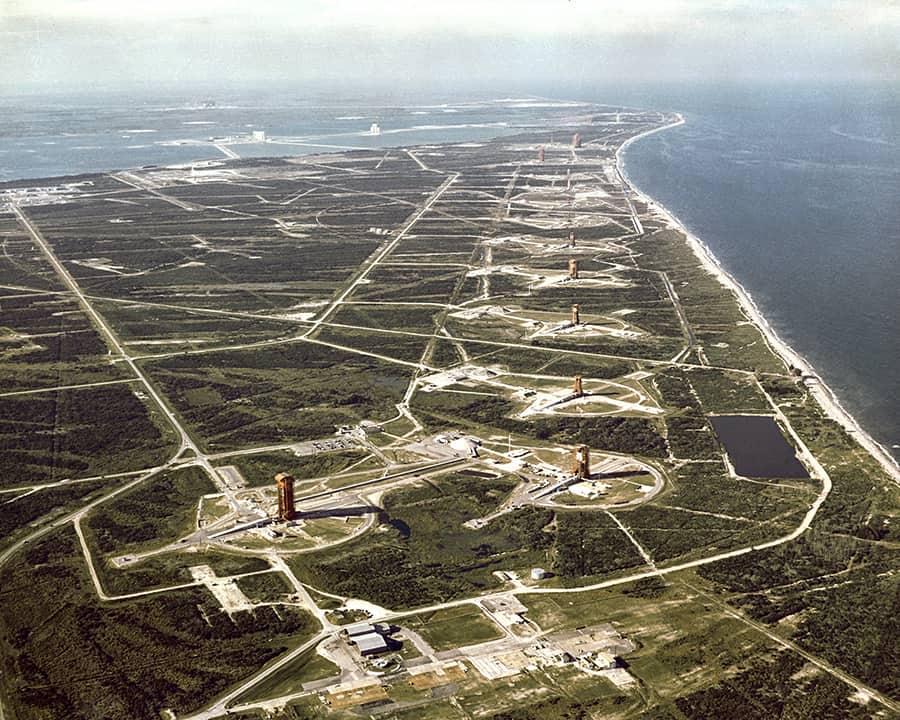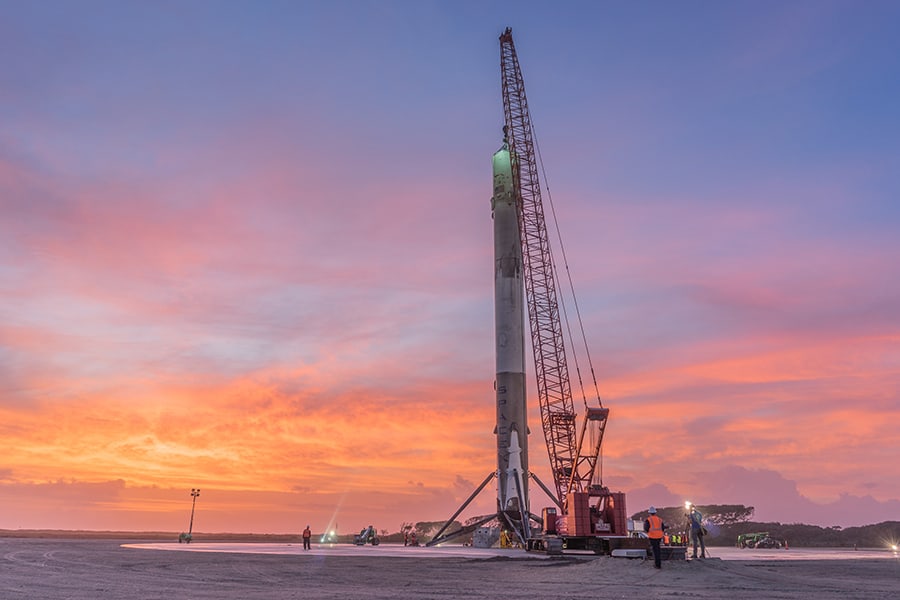Why is Cape Canaveral a launch site? It’s the perfect spot to maximize rocket speed, ensure public safety, and maintain efficient operations.
In total, there are 6 main reasons why NASA loves Cape Canaveral as a rocket launch site. I’m gonna give you the lowdown on each one, so you can understand all the ins and outs of rocket launches.
Quick history nugget: the first rocket launch from Cape Canaveral took to the skies on July 24, 1950. And even now, this far-flung marshland is one of the major U.S. spots for shooting rockets skywards. We’ve launched missions to the Moon, planets, and further from this now-famous small city in Florida.
#1 Proximity to the equator for a speed boost

It’s no secret that it costs a ton of money to launch a rocket into space. So, it makes sense to squeeze every last advantage Earth offers. One huge hidden advantage is the speed of objects on Earth’s surface.
The closer you are to the equator, the faster things go because of increased angular momentum. The result? A rocket gets a significant speed boost.
For instance, on the Earth’s equator, objects zip along at 1,038 miles per hour (mph). This means a rocket on the equator starts with a speed of 1,038 mph before it even fires up its engines. This helps it reach escape velocity with less fuel.
In other words, the nearer a rocket is to the equator, the more kinetic energy it kicks off with. As a result, it takes less energy to reach orbit. And every smidgen of energy savings is a big deal.
According to Harry W. Jones‘ paper, the cost of a rocket launch today is still high:
NASA’s space shuttle had a cost of about $1.5 billion to launch 27,500 kg to Low Earth Orbit (LEO), $54,500/kg. SpaceX’s Falcon 9 now advertises a cost of $62 million to launch 22,800 kg to LEO, $2,720/kg.
The bottom line is that penny-pinching is always the name of the game with rocket launches.
So where does Cape Canaveral fit in? It’s roughly 1,960 miles north of the equator, and it’s one of the southernmost points in the continental U.S. To put this into perspective, check out the following table showing how far popular U.S. cities are from the equator:
| U.S. City | Distance from equator |
|---|---|
| Cape Canaveral, FL | 1,961 miles |
| Houston, TX | 2,056 miles |
| Austin, TX | 2,091 miles |
| Phoenix, AZ | 2,311 miles |
| Los Angeles, CA | 2,352 miles |
| San Francisco, CA | 2,610 miles |
| Manhattan, NY | 2,813 miles |
| Philadelphia, PA | 2,813 miles |
| Chicago, IL | 2,891 miles |
To wrap your head around this speed boost, picture a record player. Put a coin near the center and one at the edge. Even though both coins orbit the center at the same speed, the one at the edge has to cover a lot more ground in the same time. So it ends up going faster.
In a similar vein, every part of Earth spins at the same rate, but the speed of different spots on the surface varies with latitude. It’s kinda like spinning a basketball on your finger: there’s no movement at the poles, but the equator gets all the action.
This is why countries tend to stick their launch pads near the equator. Here’s a table showing how close other launch sites are to the equator:
| Famous rocket launch sites | Country | Distance from equator | Angle of inclination (North) |
|---|---|---|---|
| Guiana Space Center at Kourou | French Guiana | 357 miles | 5° |
| Satish Dhawan Space Centre | India | 910 miles | 13° |
| Cape Canaveral Air Force Station | United States | 1,960 miles | 28° |
| Palmachim Airbase | Israel | 2,170 miles | 31° |
| Tanegashima Space Center | Japan | 2,170 miles | 31° |
| Vandenberg Air Force Base | United States | 2,450 miles | 35° |
| Wallops Flight Facility | United States | 2,660 miles | 38° |
| Jiuquan Satellite Launch Center | China | 2,745 miles | 41° |
| Baikonur Cosmodrome | Russia | 3,155 miles | 45° |
| Yasny Launch Base | Russia | 3,570 miles | 51° |

Important Note: Elon Musk chose Texas for SpaceX launches, too. Why? Because the southern tip of Texas is even closer to the Equator than Cape Canaveral. Plus, just on the east side of Texas, there’s the Gulf of Mexico, a big ol’ body of water.
#2 Flexibility in orbital spaceflight for satellites
When it comes to launching rockets, the equator is where it’s at. Rockets launched from this region have a lot more flexibility for reaching desired orbital paths. Picture this: a rocket can easily orbit from east to west if launched near the equator. But try to do the same near Earth’s poles, and you’ll find that you need to pour in a lot more energy to achieve that east to west orbit.
Over at Cape Canaveral, eastward launches are all about prograde orbits. We aim for geosynchronous or geostationary orbits with these launches. However, most of the launches heading North, South, or West don’t happen at Cape Canaveral due to the restrictions placed on rocket flights over land.
Let’s crunch some numbers to understand why prograde orbits are common at Cape Canaveral. First up, to enter orbit around Earth, you need to hit the speed of 17,600 mph. And if you want to completely escape Earth’s gravity, you’ll need to reach a whopping 25,000 mph.
Next, bear in mind that Earth spins at the speed of 1,038 mph at the equator. Given that Cape Canaveral is located at about 28° North latitude, we can calculate the speed boost a rocket gets at this site.
Here’s the math: 1,038 mph x cos(28°) equals a speed boost of 916.5 mph.
So, by launching eastward, in sync with Earth’s rotation, you get a significant speed boost. This results in quite a bit of savings on fuel costs.
However, attempting to get into a polar orbit from the equator will cost you extra fuel. You still need to reach 17,600 mph, but now you have to counteract your eastward momentum. This need for a course correction is why launches aiming for a polar orbit aren’t usually made from Cape Canaveral while also considering the restrictions we discussed.
#3 Public safety from rocket launch mishaps

You may look at a rocket and think it’s nothing more than a cool, simple piece of technology. But in reality, rockets are incredibly complex. They journey hundreds of miles into space and weigh hundreds of thousands of pounds. It’s not shocking then that sometimes things can go awry. After all, a rocket is essentially a controlled explosion from start to finish.
That’s why there are numerous safety measures put in place to mitigate risk, with the primary concern being human safety.
This brings us to why Cape Canaveral is such an excellent site for rocket launches. Located on Florida’s east coast, facing the Atlantic Ocean, it takes full advantage of Earth’s eastward rotation. This means rockets typically orbit in the same direction as Earth spins.
This path creates a safety zone, ensuring that the trajectory of the rockets falls over the ocean rather than populated areas. So, if there’s any debris from the rocket, it’ll splash down safely into the Atlantic Ocean. Moreover, reusable rocket parts can parachute down for later recovery without causing any harm.
#4 Accessibility and easy transportation
Cape Canaveral is like a dream come true when it comes to its easy access to transportation waterways. Transporting large, heavy equipment to the site is as easy as pie, given that moving big stuff by sea is generally simpler than by land.
Think about it like this: take a look at land-based wind turbines. Engineers have to limit their size because there are only so many places you can take something that big. For example, if a turbine blade gets too large, it’s not going to shimmy under every bridge.
So, as rockets keep getting larger, Cape Canaveral’s popularity is only going to grow.
Another perk is that heavy-traffic shipping lanes aren’t anywhere near the launch area. Even if any ships do stray into the launch area, it’s easy to nudge them onto a different route.
#5 Existing rocket infrastructure

Cape Canaveral wasn’t always synonymous with rocket launches. Back in 1949, it was the spot where the U.S. government was test-firing missiles. Even then, its nearness to the equator and safety features were big advantages.
So, when it comes to rocket infrastructure, Cape Canaveral was already ahead of the game with stuff like launch pads in place. This meant that when NASA stepped onto the scene, they could simply repurpose a lot of this existing setup for their rocket launches. Considering that missiles and rockets are more or less distant relatives, it was a no-brainer. You could say that NASA and the existing infrastructure were a match made in, well, the cosmos.
On top of all this, when NASA gave the thumbs up to the site, it was pretty much a blank canvas. Yeah, there was loads of open space for expansion, but there were also handy paved roads already in place from the Air Force’s missile testing days. This meant NASA didn’t need to start from square one to get the site humming for rocket launches.
#6 Pristine weather
Let’s talk weather. Cape Canaveral sports some pretty amazing weather throughout the year. The table below shows the average temperature for each month of the year, making it possible to launch rockets all year round. I mean, who’d want space travel to be just a seasonal thing, right?…
| Month | High temperature (Fahrenheit) | Low temperature (Fahrenheit) |
|---|---|---|
| January | 72° | 51° |
| February | 74° | 53° |
| March | 78° | 57° |
| April | 81° | 62° |
| May | 85° | 68° |
| June | 89° | 72° |
| July | 90° | 73° |
| August | 90° | 74° |
| September | 88° | 73° |
| October | 84° | 68° |
| November | 78° | 60° |
| December | 74° | 55° |
According to Weather Spark,
“In Cape Canaveral, the summers are long, hot, oppressive, wet, and mostly cloudy and the winters are short, cool, windy, and partly cloudy. Over the course of the year, the temperature typically varies from 54°F to 89°F and is rarely below 40°F or above 92°F.”
Sure, there are some thunderstorms, heavy rain, and hurricanes now and then. But overall, the weather is pretty ideal for rocket launches.
“Why is Cape Canaveral a launch site?” wrap up
You might ask, isn’t there land closer to the equator than Cape Canaveral? But think about it: what U.S. territory is closest to the equator? Yep, you guessed it. It’s Florida!
Plus, almost all other potential sites aren’t on the mainland U.S.
So, from a business and economic standpoint, sure, there are trade-offs. But all things considered, Cape Canaveral is like the Goldilocks of rocket launch sites. It’s as if Earth handed us this spot and said, “Here’s your springboard to the cosmos.”
Let’s just hope Cape Canaveral doesn’t disappear with rising ocean levels in the future. That’d be the only reason we’d ever want to abandon this precious launch site. It’s just too perfect, ticking every box you’d want in a rocket launch site.
What do you think is the most crucial factor out of the six we discussed? Do you believe Cape Canaveral is the best launch site in the U.S. for rockets?
Featured Image Photo Credit: NASA (image cropped)
